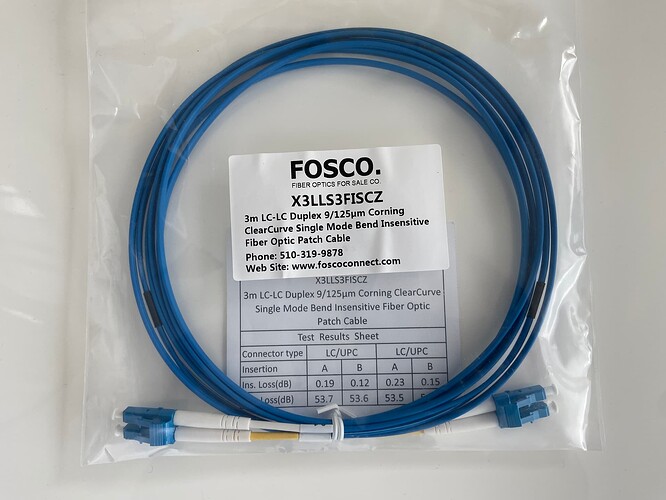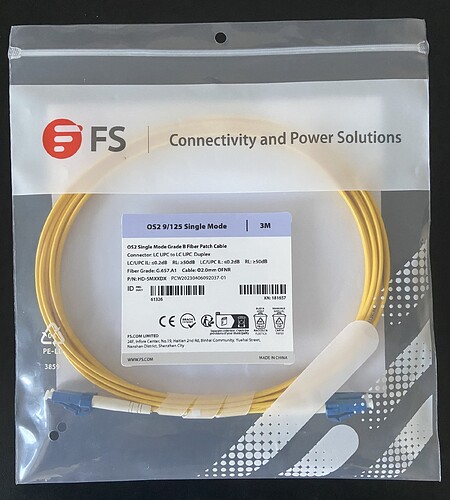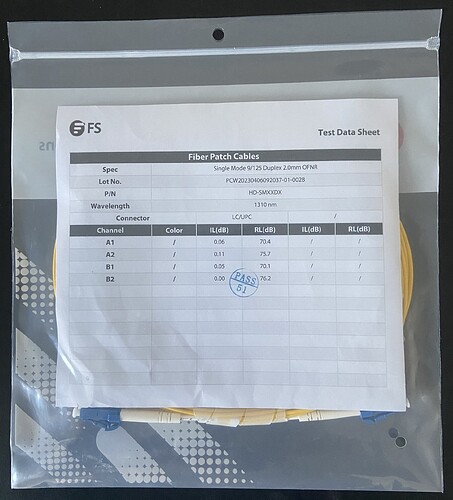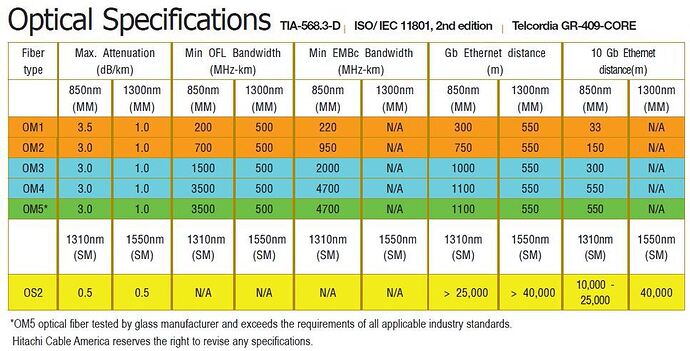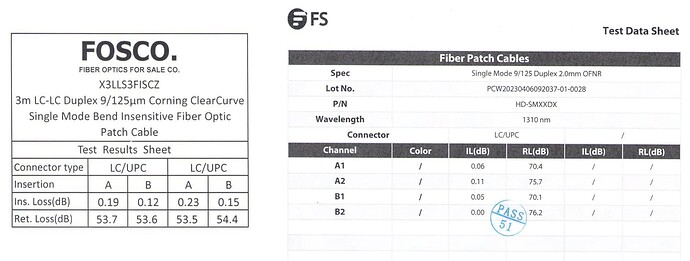Just heard back from FOSCO, where I purchased the single-mode Corning ClearCurve fibre patch cord from the link supplied on the Lumin webpage. The company says the connector is Grade A, with concentricity ≤1.0.
Thanks - Grade A is not yet formally defined in IEC 61753-1
Torben
Here a pic - has just arrived:
LC-LC Duplex 9/125µm Corning ClearCurve Single Mode Bend Insensitive Fiber Optic Patch Cable
Torben
I guess it has a Grade A connector, even though the description is not on the supplied test sheet. Regardless of whether the insertion standard for Grade A hasn’t been approved by the applicable standard it should work nicely! ![]()
Does anyone know the difference between these two Corning lines:
- ClearCurve Bend Insensitive
- SMF-28 Ultra
The Ultra is more expensive. That’s about all I can really gather.
So, just an update on my active cable experience. While initially not as clear as my Corning/Finisar combo, it eventually settled in and sounded pretty equal. I gave it about 10 days and no further improvements came. Since this was a much cheaper way to go than my original setup it’s hard not to recommend it. I went back to my Corning/Finisar gear but will be keeping the active cable for probable future use at another location in the house. Here’s the link for the active cable I used (I had an extra “s” in the link I posted above); Finisar SFPWire® FCBG110SD1C01 10G Active Optical Cable — Transceiver USA
Please describe the network topology and where this active cable is connected to at both ends.
Since this is 10G SFP+, it would probably not work when plugged directly into a Lumin X1 / P1 / U2, although it also depends on the other end.
In my case, it was attached to this converter on the front end: https://www.amazon.com/dp/B0957KJ8BZ?psc=1&ref=ppx_yo2ov_dt_b_product_details, and an Ether Regen on the back end.
Customized Grade B Duplex Typical 0.12dB IL OS2 Single Mode LC/SC/FC/MU 2.0mm Bend Insensitive Fiber Optic Patch Cable has arrived:
Torben
I’ve been involved in fibre optic since the '80s, well before the internet was around. There are differences between single-mode and multi-mode fibre, yes. The differences only become apparent in the realms of 10Gbit ethernet and only over very long runs.
For those worrying about differences between single mode and multi mode over the lengths in the average household at Gbit, my advice is don’t. It makes no difference. Even at 10Gbit, multi-mode is good for 300 metres. Sonic differences, absolutely not. At Gbit, OM3 is good for a kilometre of fibre. Invest your efforts in more meaningful and productive areas of audio reproduction.
I’m not a Lumin user, although I am considering the P1 as a way of simplifying my system. But I can vouch for the fact that single mode has sounded better than multi whenever I’ve compared. I do have the Sonore optical kit. I bought it after having some HQPlayer dropout issues with the opticalRendu. It didn’t solve that issue so I switched back a few days ago. The single mode (with Finisar) sounds better.
These improvements in sound you speak of, were they in blind or sighted listening comparisons?
Blind for my wife. Her hearing is even better than mine, so if she comes to the same conclusions, I know I’m not hearing things that aren’t there. Doing these types of comparisons for 30 years does allow one to develop the ability to make these comparisons accurately.
Ah, the old “my wife could hear the difference from the kitchen” story…
The only way to make comparisons between different audio configurations is to make them unsighted. Someone else makes the changes and you listen for differences.
There’s no way you can hear a difference between single mode and multi mode fibre transmitting audio data.
If you’re adamant there is, then present me with a rational hypothesis as to how a difference can exist, then I might take you seriously.
I see numerous posts on audio fora from people waxing lyrical about the effects of ethernet on audio who have zero understanding of how any of this stuff actually works.
Yes, it was unsighted. And consistent. I’m surprised you can’t hear the difference…
The temporal dispersion difference between single mode and graded index multi mode fibre is around 0.2 picoseconds per metre.That’s 0.0002 billionths of a second. In itself a difference that small is utterly inaudible. Data is transmitted over ethernet via a protocol known as TCP/IP. Data is sent in packets and checksummed/validated and buffered at each interface. So it’s asynchronous.
You still haven’t presented a rational argument as to how there can be a difference. The data is the same via single mode or multi mode. If it wasn’t, the TCP/IP checksum would fail. So if the data being presented to your streamer is the same in both cases, which is in turn fed to your DAC, how can it sound different?
Your claim of being able to hear it doesn’t cut it.
Please do not turn this thread into yet another “bits are bits” discussion - I’m sure there are many new and old threads for this issue, but this thread we’re in is not the thread for it.
This thread is about subjective experimental findings of their gear.
There are many different types of optical fiber cables that can be used for communication and connectivity between devices like routers, switches, transceivers, etc. Generally speaking, these cables are terminated through optical connectors, and in a few cases, splicing is preferred. Return Loss (RL) and Insertion Loss (IL) are two critical parameters that give us information about the attenuation effects across fiber connectors.
Insertion loss – IL (dB)
Insertion loss is a term used to indicate the losses in signal power and it is indicated as a ratio (in decibel or dB). It is important to understand that a higher insertion loss value indicates a poor insertion loss performance I.e., an insertion loss of 0.2dB is better than 0.6dB.
Return Loss – RL (dB)
In any optical fiber transmission line, a certain number of light rays tend to reflect and return to the point of origination or source because of inherent discontinuities and impedance mismatches in the Return loss is a term that can be defined as the loss of power in the signal reflected or returned by a discontinuity in an optical fiber or transmission line and it is denoted as a ratio in decibels. A high return loss is considered a good indication because it shows that the lines or devices connected through lines are well matched.
Below a comparison of:
Fosco: LC-LC Duplex 9/125µm Corning ClearCurve Single Mode Bend Insensitive Fiber Optic Patch Cable
and
FT: Customized Grade B Duplex Typical 0.12dB IL OS2 Single Mode LC/SC/FC/MU 2.0mm Bend Insensitive Fiber Optic Patch Cable
Torben
Well said Peter. I much prefer to read about people’s personal listening experiences than the well worn and by now very boring “bits are bits” arguments or those that postulate if it can’t be proved scientifically then it doesn’t exist. There is much science hasn’t been able to explain including our own consciousness. I have had a deep interest and respect for science since I was a child but for some it has become a new religion that can’t be challenged for fear of derision by the true believers. The fact is we don’t know what we don’t know. So to those experts out there please continue to use and enjoy your expertise but please leave the rest of us to enjoy our hobby and the choice to spend our money wherever we choose without your unrequested advice.
Torben, please don’t try to teach me what I already know.
If the insertion and return losses were a significant enough issue, TCP/IP checksum would fail, and packets would be retransmitted or dropped.
My Roon core lives on a Synology NAS, which is also a media and data server and hosts a bunch of IP cameras.
It does all that over 40 metres of OM3 multi-mode fibre.
The very notion that OS2 is better for audio over short distances than OM3 is utterly preposterous.
